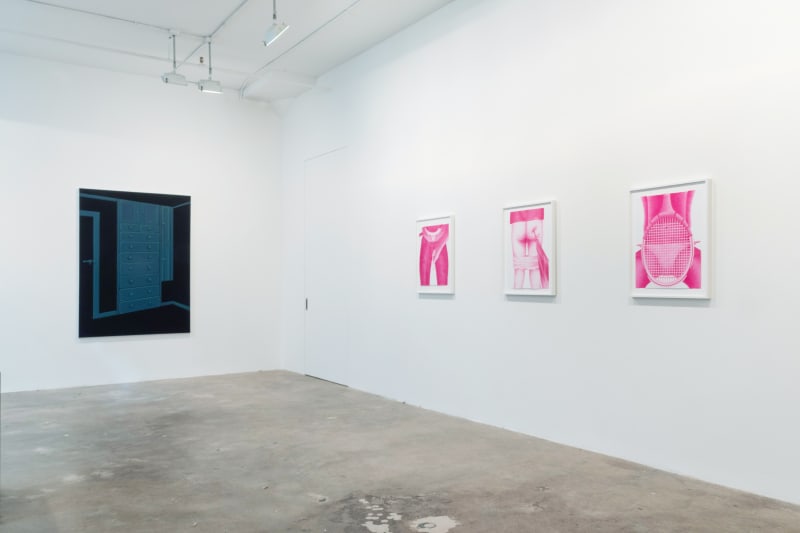Hesse Flatow is pleased to present Table Manner, showcasing the collaged paper works of Anthony Iacono, the multi-material sculpture and wall works of Sacha Ingber and oil paintings by Caitlin MacBride. While the materials and subject matters are diverse, each artist asserts a meticulous control over the materials used, while allowing the content of the work to behave as the expressive quality of the work. MacBride's figure-absent settings, Ingber's sensual-teasing surfaces and Iacono's tension-filled collages all seem to reveal an anonymous partner. A focus on imagery of handheld objects, tools or furniture spans all three artists work. Using motifs from interiors or domestic settings, Iacono, Ingber, and MacBride all create backdrops that act as cues for the setting of a stage. Objects appear as animated as the social cues and characters that create a moment.
Iacono's meticulously hand-cut collages are zoomed in depictions of bodies; a figure removing their belt or a tennis racket framing someone's groin as if its a magnifying glass. These works seem to tell the story about the moment right before the story begins, clues to what's occured or what's to come seemingly always holding an erotic tension. This restraint highlights a fascination in the encounters of objects between bodies.
Ingber's works use plastic resins, ceramic, and various materials that behave at first glance like decorative surfaces or crests. Before they are perceived as paintings or sculptures, they could masquerade as familiar interior forms that fit within a wainscoted room of wood panelling. Upon closer inspection, these works contain highly specific recognizable motifs of objects and images.Through a mold-making and casting process, forms are inlayed into textured surfaces, sometimes as iconic silhouetted forms, alongside some which are more rendered and sculptural. For Ingber, trompe l'oeil is used to create cues. These vignettes act like pictograms to decode sensation and emotional memory. Ingber's objects gradually render a character who inhabits her spaces. The body that resides in these interior worlds becomes the architecture itself.
MacBride's oil paintings depict Shaker and early Colonial furniture and tools in nondescript and graphically absent backgrounds. Her interest in Shaker design began in relation to the history of the area where she was raised in New England. Shaker beliefs about celibacy and equality among its members, and approaching spirituality through labor and craftsmanship became guides for a study of American object making. In MacBride's paintings, Shaker furniture and tools are painted similarly to a portrait rather than an interior or a still life. These objects are painted with an adoring love, painstakingly perfected in their creation while also serving their "denial of the flesh" without any sense of a figure. These "transitional objects" can convey the importance of what a human has put on to it, and serve as the component placeholder to the figure or a character.

